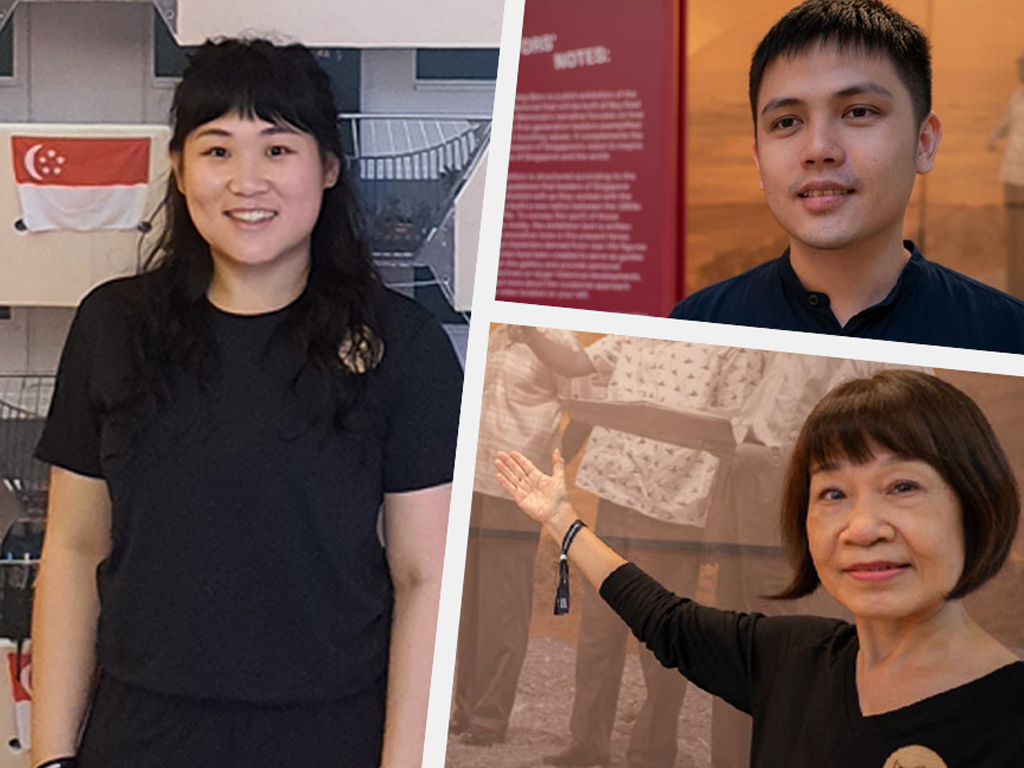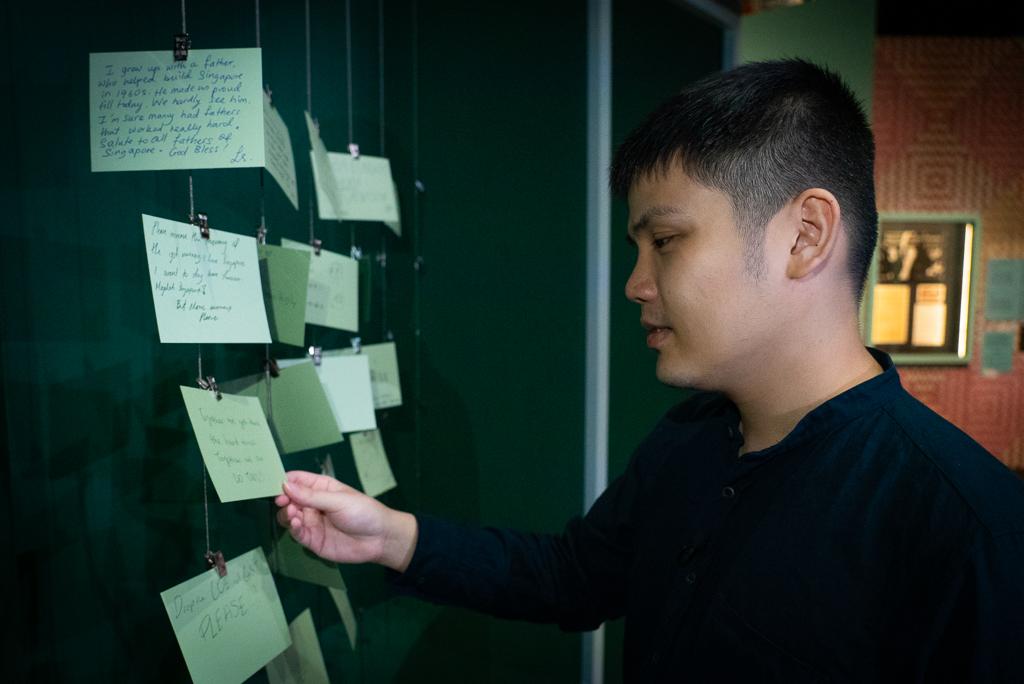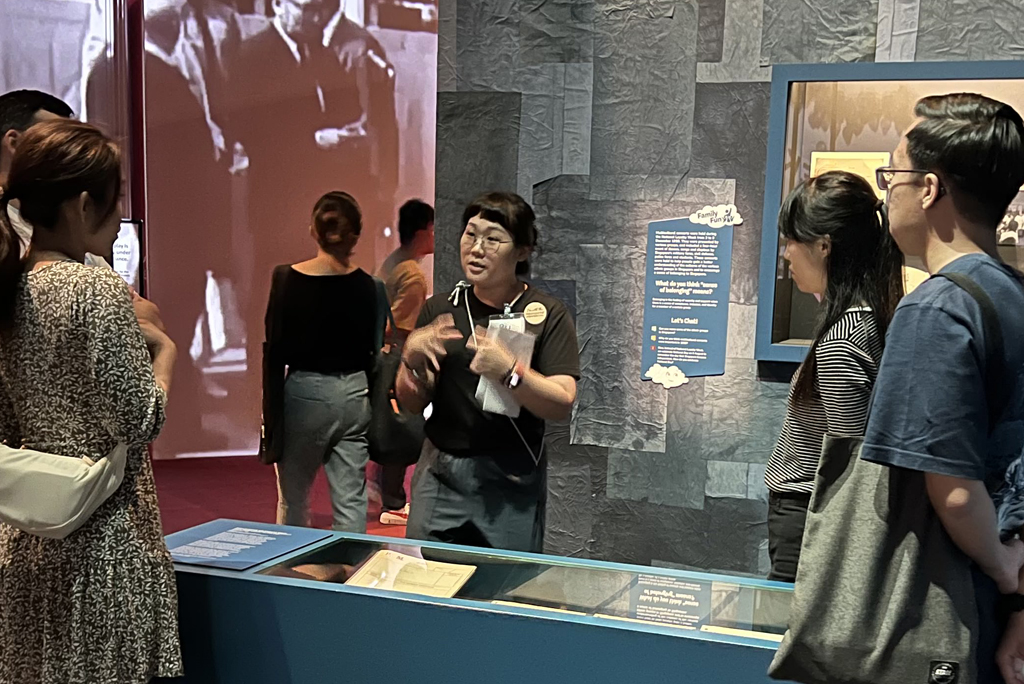The birth of a nation in 600 square metres: Meet the museum curator and volunteers breathing new life into the Singapore Story
We peek behind the curtain of the Founders’ Memorial pilot exhibition Semangat yang Baru: Forging a New Singapore Spirit
- 19 Oct 2023

Three of the faces behind Semangat yang Baru (clockwise from left): Volunteer Tan Shun Ru, curator Joshua Goh, and volunteer Josie Ho.
When he first started at the National Heritage Board as an intern, Joshua Goh guided visitors at community galleries and on heritage trails. “It was a lot of micro-history,” he recalls.
A few years later, his first curatorial assignment is The Founders’ Memorial’s pilot exhibition Semangat yang Baru (now running at the National Museum until 13 November), which tells the epic story of Singapore’s tumultuous, early nation-building years.
No pressure, right?
“There are already several Singapore history galleries at the National Museum,” says veteran museum volunteer Josie Ho, “it’s so important to highlight to visitors that it’s not just more of the same.”
A few years later, his first curatorial assignment is The Founders’ Memorial’s pilot exhibition Semangat yang Baru (now running at the National Museum until 13 November), which tells the epic story of Singapore’s tumultuous, early nation-building years.
No pressure, right?
“There are already several Singapore history galleries at the National Museum,” says veteran museum volunteer Josie Ho, “it’s so important to highlight to visitors that it’s not just more of the same.”

Joshua, curator of Semangat yang Baru, wanted to combine the best of both traditional and experiential museum exhibitions.
Putting the Pieces Together
From the outset, Semangat yang Baru employed a crowdsourcing and consultative approach.A year prior to the exhibition's launch, the Memorial organised a public campaign and travelling exhibition to encourage Singaporeans to come forward with their stories and artefacts. This pop-up travelled to various locations around the island, including neighbourhood shopping malls, libraries, community centres and schools.
Volunteer Tan Shun Ru recalls that members of the public would show her old photos on their camera rolls, describe potentially interesting items they had in storage, and tell her about living through the advent of TV and other milestones.

Wildlife educator Shun Ru (middle) showing visitors around at the Semangat yang Baru exhibition. Shun Ru had also volunteered at the earlier pop-up version of the exhibition. Photo credit: Shun Ru.
I think a lot of Singaporeans want their stories to be known, but don’t feel like they’re significant enough for a museum space. But I think it’s all the little stories that brought us here.
To acquire objects like a pig-weighing scale from retired farmers who once worked in Singapore’s pig-farming industry, Joshua made home visits to take measurements and record oral history.
“It’s a process of careful selection,” he says, “we couldn’t just present rows and rows of artefacts, it needed to be a storytelling journey.”
In the exhibition, everything from artworks to a disused floodlight from the former National Stadium are used to flesh out the zeitgeist of Singapore’s early independence.
Walkthrough and feedback sessions determined whether gallery captions should be in past or present tense, and which set of fictional character guides (there are six to choose from) could best represent Singapore’s diversity.
“It’s a process of careful selection,” he says, “we couldn’t just present rows and rows of artefacts, it needed to be a storytelling journey.”
In the exhibition, everything from artworks to a disused floodlight from the former National Stadium are used to flesh out the zeitgeist of Singapore’s early independence.
Weaving historical threads into national fabric
The public had a big role in shaping Semangat yang Baru’s visitor experience, too.Walkthrough and feedback sessions determined whether gallery captions should be in past or present tense, and which set of fictional character guides (there are six to choose from) could best represent Singapore’s diversity.
.jpg?h=683&w=1024&la=en&hash=586B9FC9E52F0845C38DCBB32CFE1988)
The Semangat yang Baru exhibition at the National Museum captures the dynamism of our early years, where people rallied together to build the nation. Photo credit: NHB
The result is a multi-layered narrative that makes textbook history new again, revealing the past is neither static, separate from the present, nor easily taken for granted.
Semangat yang Baru has moved some audiences to consider “what if?”, according to Shun Ru: younger audiences particularly enjoy unused versions of the Singapore flag and anthem that could have been.
Even the exhibition’s title, taken from the Singapore anthem’s second half and translating to “new spirit”, prompts reflection.
Semangat yang Baru has moved some audiences to consider “what if?”, according to Shun Ru: younger audiences particularly enjoy unused versions of the Singapore flag and anthem that could have been.
Even the exhibition’s title, taken from the Singapore anthem’s second half and translating to “new spirit”, prompts reflection.
.jpeg?h=684&w=1024&la=en&hash=88568DCAAEAED78DDD5A3424F82B78DB)
Josie is a retiree who also volunteers with elderly people and patients in hospice care.
“One time at the entrance, some young women asked me why “Semangat yang Baru” sounded so familiar,” says Josie, “I began to sing and it finally clicked for them. They joined in and we had a good laugh after.”
Most of all, Semangat yang Baru is about the things that still drive Singapore’s present.
Most of all, Semangat yang Baru is about the things that still drive Singapore’s present.
Singaporean identity should remain expansive, because any rigid idea of what it means to be to be Singaporean becomes a matter of including and excluding.
For Joshua, 20th century Singapore’s story of rapid change has never ended: “our national identity continues to be shaped by forces that are both local and global.”
He hopes that visitors take Semangat yang Baru’s message of growth and adaptation to heart.
“Every time I’ve volunteered at the exhibition, it’s felt like a renewal of my pledge,” says Josie, “at 63, every line feels more precious to me now than ever.”
He hopes that visitors take Semangat yang Baru’s message of growth and adaptation to heart.
“Every time I’ve volunteered at the exhibition, it’s felt like a renewal of my pledge,” says Josie, “at 63, every line feels more precious to me now than ever.”






